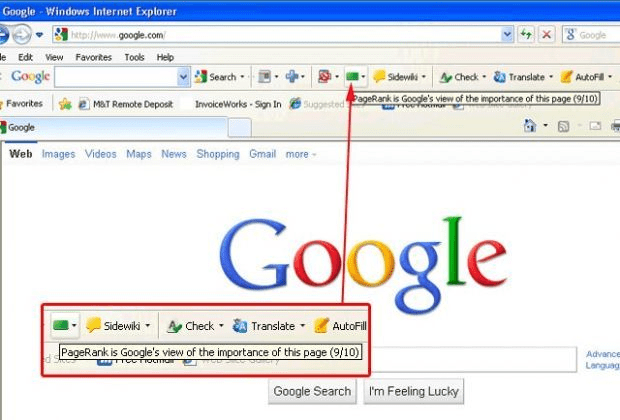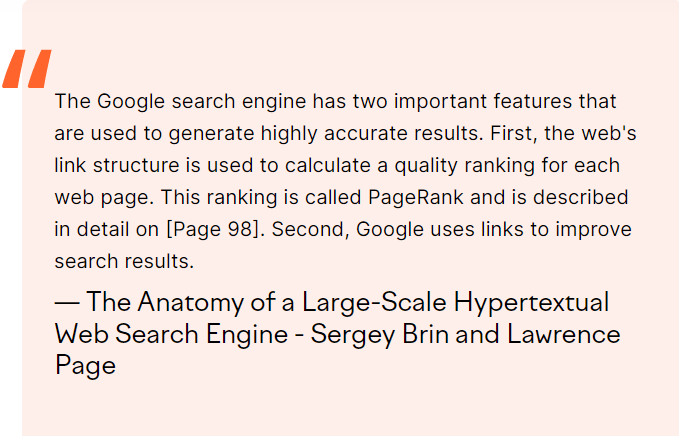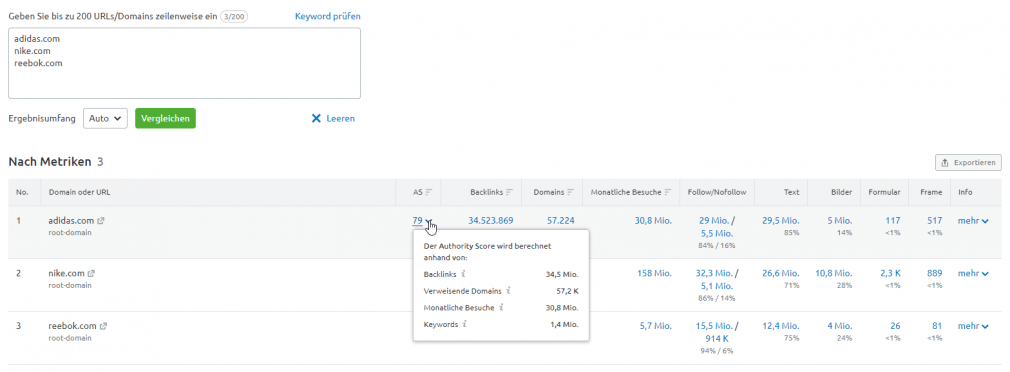Just ten years ago, PageRank was the SEO metric everyone was talking about.
If you’ve been in the industry for a while, you’ll remember the excitement when it was announced that the PageRank Toolbar had been updated once again.
With any luck, your recent efforts resulted in an increase in your site’s PageRank, meaning that Google attributed more authority to your site than before.
An increase in your PageRank scores is the best proof that your SEO strategy (and especially your link-building strategy) is working.
We go back to 2021 and discover that PageRank is hardly mentioned anymore.
But that doesn’t mean the metric isn’t important anymore. It just isn’t publicly available anymore. And when SEOs can no longer measure something, they eventually stop talking about it.
In this guide, we’ll take a closer look at what you need to know about Google PageRank and what matters in 2022.
Table of Contents
What is PageRank?
If you remember PageRank, this is probably the first thing that comes to mind when you hear the term:

That was Google’s infamous PageRank toolbar.
This is what we all associated with PageRank and the metric that SEO people were obsessed with back then.
However, there is much more to PageRank than just the toolbar.
PageRank – a system for ranking websites
PageRank is a system for ranking websites that was developed by Google founders Larry Page and Sergey Brin at Stanford University. PageRank is all about links.
The higher the PageRank of a link, the more authority it has.
In simple terms, we can describe the PageRank algorithm as a method of measuring the importance of a web page based on the quantity and quality of the links pointing to it.
The PageRank score
Unsurprisingly, PageRank is a complex algorithm that assigns a score to websites.
But in everyday search engine optimization, PageRank came across as a linear representation of a logarithmic scale from 0 to 10, displayed in the PageRank toolbar.
A PageRank of 0 is usually a low-quality website. On the other end, only the most important pages on the web received a 10 rating.
In order to interpret PageRank values, one must realize that they are based on a logarithmic scale. Not sure what that means?

As noted by Search Engine Watch, PageRank “has an estimated base of 4-5. In other words, assuming a base of 5, a PR2 link is comparable to 5 PR1 links; a PR6 link is comparable to 5 PR5 - Left and therefore on.”
It quickly becomes apparent that one PR10 link is comparable to thousands of PR1 links.
The reason SEO practitioners have become so obsessed with this metric is that PageRank is passed from page to page. A website gains authority when it links to another site with a higher PageRank score.
PageRank values, passed between websites via links or backlinks, help those websites rank higher in search results. The algorithm is based on the concept that a page can be considered important if other important pages link to it.
Google still uses PageRank as part of its algorithm today, but the original patent has expired and it hasn’t been used in its original form since 2006. The patent currently in use is much more complex.
The history of Google PageRank at a glance
The first PageRank patent, filed on September 1, 1998, became the original algorithm that Google used to calculate the importance of web pages and rank them by relevance.
In short, Google is actually based on Sergey Brin’s idea that information on the web could be ranked by link popularity. The more links pointing to a page, the higher it’s ranking.
And if we look at the concept that Google introduces, we clearly see the reference to PageRank when describing the features of the search engine:

PageRank is literally the factor that made Google so unique.
The document goes on to explain, “The Web Citations (Links) Table is an important resource that has gone largely untapped in existing web search engines.”
Introducing the Google Toolbar
In 2000, Google introduced the toolbar we all remember. This allowed us to see the PageRank score of our websites and those of our competitors.
As a result, many SEOs have developed a fixation on PageRank as what seems to be the single most important metric for improving their rankings. This was basically based on a simplified understanding of the algorithm, which assumed that the web page with the most links always received the highest ranking.
In the early 2000s, many simply pursued the goal of getting as many links as possible from websites with the highest PageRank possible.
Of course, this has also led to attempts to manipulate PageRank. Money changed hands for links and so-called link farms emerged.
In 2014 Google stopped updating the publicly available toolbar (the last confirmed update was in December 2013), in 2016 the toolbar was finally buried.
However, that doesn’t mean that PageRank is no longer part of Google’s algorithm, just that it’s no longer a publicly available metric.
An updated PageRank patent
The 1998 PageRank patent expired in 2018 and, to the surprise of many observers, was not renewed. At that time, a former Google employee confirmed that the original algorithm hadn’t been used since 2006.
But that doesn’t mean PageRank is dead.
The original patent has been superseded by this new one. To fully understand the differences from the original, we recommend this analysis by Bill Slawski.
The new patent refers to “seed sites in trusted seed sets” and defines them as “…specially selected high-quality pages that provide good web connectivity to other non-seed sites.” The Google Directory (which still existed when the patent was filed) and the New York Times are cited as examples of such sites.
“[Seed sites] should be reliable, diverse enough to cover a wide range of topics of public interest, and well-connected to other sites. They should have a large number of useful outbound links to allow other links to be identified as useful and high-quality websites by acting as ‘hubs’ on the web.”
The new patent assigned a ranking score to a website based on its removal from a set of seeds. However, this patent makes no reference to PageRank. It is also not presented as an updated version of the algorithm.
Rather, it is considered by the SEO community as a PageRank modifier that takes into account proximity to the starting set of websites.

How PageRank Works
PageRank is fascinating.
This is something every SEO (and backlink building) manager should understand thoroughly if only to understand why links continue to be one of Google’s top three ranking factors.
When the patent was filed and Google’s first algorithm was developed, the theory was that a link from one website to another acted as a vote of confidence and authority. The more links (votes) a page had, the more trustworthy it had to be and therefore received a higher ranking.
However, as stated in the original concept, “PageRank extends this idea by counting links from all pages unequally and normalizing them by the number of links on a page.”
A link is not just a direct vote. The authority of a page is also taken into account. A link from a PageRank 6 page has more weight than a link from a PageRank 2 page.
The PageRank flow between pages is also called “link juice” by SEO specialists.
But let’s look at the calculations behind PageRank:
“We assume that page A includes pages T1…Tn that refer to it (i.e. are quotes). The parameter d is a damping factor that can be set between 0 and 1 We usually set d to be 0.85. More details about d follow in the next section. C(A) is also defined as the number of links coming from page A. The PageRank of page A is given as follows :
PR(A) = (1-d) + d (PR(T1)/C(T1) + … + PR(Tn)/C(Tn))
Note that PageRank values form a probability distribution between websites, so the sum of all PageRanks of all websites equals one.”
In simpler terms, this means PageB’s PageRank is calculated by multiplying PageA’s PageRank by 0.85. This is the damping factor.
If Page B is then linked to Page C, it will get 85% of B’s PageRank (72.25% of Paget’s PageRank).
If there is no link pointing to a website, it does not start with 0 PageRank, but with 0.15.
It becomes more complicated when a page contains more than one external link.
As detailed in this 2004 post to the Search Engine Roundtable:

PageRank is complex. To better understand how it works, you can read this detailed guide which provides an introduction to PageRank for SEO.
PageRank Factors That Still Matter
We have already pointed out that not all links are equal in terms of past PageRank. But what factors make the difference?
Below we take a closer look at some aspects:
- anchor texts
- click probabilities
- Internal links (internal linking)
- no-follow links
Not only do you need to understand what the influencers are, but also what they mean for SEO in 2021, how to take advantage of them, and what tactics to avoid when considering these factors.
Learn the difference between do-follow and no-follow backlinks.
anchor texts
Regarding link anchor text, Google’s concept paper noted that “link text is treated in a special way in our search engine” and that “anchors often provide more accurate descriptions of web pages. than the pages themselves”.
In the early days of Google, anchor text had a crucial impact on a page’s ranking.
If you wanted to be visible for the term “red shoes,” the more links pointing to your pages using that term as anchor text, the better your chances.
Link building has become a race among SEO specialists to see who could get more links with exact matching anchor text from high PageRank sites.
This worked (for a while) but was a manipulation of Google’s webmaster guidelines and is considered a signal for a link exchange program.
In 2021, excessive exact match anchor text can be considered toxic links and lead to manual penalties or algorithmic adjustments.
click probabilities
The likelihood of a link being clicked is a major factor influencing PageRank and is mentioned in Google’s Reasonable Surfer patent.
The original PageRank algorithm gave equal weight to links on a page. However, the 2004 Reasonable Surfer patent pointed out that not all links are equally likely to be clicked. Therefore, he weighted the links differently based on the likelihood of them being clicked.
Examples of links that get fewer clicks include links to terms and conditions and banner ads. But it can also just be a link in a footer or similar place.
Internal links
There’s a good reason why internal linking is an important SEO tactic.
With a solid internal linking structure, you support the PageRank flow on all pages of your website. Once you understand how this works, it’s easy to see why this tactic can have such tangible effects, especially when linking to pages that otherwise don’t have inbound links.
No-follow Links
No-Follow links prevented PageRank sharing until September 2019.
Previously, SEOs used the no-follow attribute to design the PageRank feed. If a page had five external links, all PageRank would go through the one follow the link if the other four had a no-follow attribute.
However, in 2009 Google’s Matt Cutts confirmed that it would no longer work. PageRank was now divided by all links, even if No-Follow attributes were set. However, only links without a no-follow attribute also passed PageRank. The remaining PageRank fell.
Why did Google discontinue the PageRank toolbar?
Search engine optimizers became obsessed with PageRank and quickly paid more attention to its score than to the content creation and usability of their pages.
The problem was that making the PageRank score public made it easier to manipulate the value.
SEO practitioners knew how to use PageRank to achieve higher rankings for their websites and they took advantage of it.
From Google’s perspective, the PageRank public toolbar was the problem. Without it, there was no accurate measure of a website’s authority (officially, at least).
Ultimately, SEO specialists misused PageRank to manipulate rankings. Google had no choice but to phase out the toolbar, which eventually happened in 2016.
Why do PageRank Still Matters in 2022?
PageRank is still important in 2022.
The fact that there is no longer a toolbar that tells us the PageRank score of a website does not mean that it is no longer used.
In fact, Google’s Gary Illyes confirmed on Twitter in 2017 that the search engine still uses PageRank.
PageRank has never gone away, and understanding how it works can only improve your SEO skills. If you haven’t read Google’s concept paper yet, you should.
Is there a replacement metric for PageRank?
Google never released a new version of the PageRank toolbar, but PageRank is still used by the search engine.
We simply no longer have a tool to measure it.
A number of software tools and SEO platforms have introduced their own authority metrics. Among them is the Semrush Authority Score.

Authority Score is an aggregated domain score that rates the overall quality of a website and tells you how effective a backlink from a website can be for your SEO. It’s based on:
- Backlink data includes referring domains, follow & no-follow links, and other characteristics.
- Organic search data, including organic searches and keyword positions.
- Site traffic data (monthly visits).
Of course, the metric also uses backlink data as part of the scoring algorithm. However, their purpose is not to directly replace PageRank.
It is important to understand.
Third-party metrics are not used in Google’s algorithm. However, they can help you gauge a site’s relative authority over its competitors and other sites on the web.
Conclusion: PageRank is not dead
We may not have a toolbar anymore, but that doesn’t mean we don’t need to understand how the metric works and what factors affect it.
In many ways, it’s a good thing that optimizers stopped caring about PageRank. Since then, manipulation tactics have played less of a role.
SEO specialists abused PageRank and that’s why we lost the toolbar, but maybe the end result isn’t so bad.




1 Comment
0.1 dollar
Do you mind if I quote a couple of your articles as long asI provide credit and sources back to your website?My blog site is in the very same niche as yours and my users would certainly benefit from some of the information you present here.Please let me know if this okay with you. Thanks!